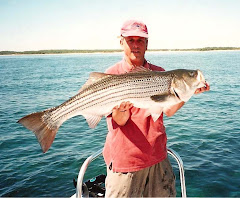About this time each winter I begin reading feverishly any materials related to the outdoors. Much of that has to do with the onset of seasonal affective disorder arising both from fewer hours of daylight and less time outdoors. I also spend more time at my tying vise adding to an already humungous inventory of flies. The reading and the tying both help alleviate the symptoms of fishing withdrawal. I was at the vise the other day looking through one of my many fly wallets and came upon a pattern that I originated for Alaska silver salmon about a dozen years back. It is a fly that has served me well on numerous salmon trips. The pattern has relevance to the local fishing scene since I modified it for use on striped bass. So I figured I would share the history and the tying pattern
When it comes to fly tying I take my inspiration however I can get it. I learned a long time ago that some of the best of tying ideas sometimes come from the most unusual sources. And so it was with the Alaska Margarita. I guess I must first admit to being a Parrot Head, a disciple of lord Jimmy Buffet. While reading the recipe for his sublime margarita concoction I got to thinking about all the tropical colors associated with the blend and instantly thought about how those colors might work in a fly design. The more I contemplated the design, the more I became convinced that coastal silver salmon would just go bonkers over a fly with those hues, tones and contrasts. When I finally got to try out the fly on some feisty silvers, I wasn’t at all disappointed. As it turned out, striped bass also love the pattern.
The most tantalizing effects of the fly result from the pulsating and undulating motion of marabou. The striper version incorporates the addition of a slender saddle hackle tail. That too adds seductive appeal. The bead chain eyes in the weighted version also allow for a jig-like motion to be achieved during the retrieve. That combined with the blended colors - proven over time to stimulate strikes from silver salmon - has led to an effective and dependable series of patterns. By varying the color combinations, the pattern becomes a very versatile fly for replicating a wide variety of bait, and for addressing different fishing conditions. Though I have not yet discovered all the secrets of the perfect margarita, the “margarita” and its variations come close to being some of the best patterns that I have used for tidal cohos and striped bass.
Monday, February 23, 2009
Subscribe to:
Posts (Atom)










